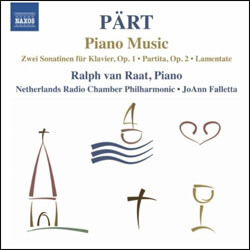 Pärt Piano Music by Naxos features pianist Ralph van Raat interpreting the Estonian composer’s music spanning over four decades. This retrospective takes us on a stylistic journey that is truly millennial in scope, while remaining reverent in spirit.
Pärt Piano Music by Naxos features pianist Ralph van Raat interpreting the Estonian composer’s music spanning over four decades. This retrospective takes us on a stylistic journey that is truly millennial in scope, while remaining reverent in spirit.
The first of the Zwei Sonatinen, Op. 1 (1958), shares much of the language of Pärt’s elder contemporary, Shostakovich, with acrobatic melodies supported by harmonies that become only occasionally dissonant, and then only through linear voice-leading. Ralph van Raat plays the allegro passages with a digital precision characteristic of post-war piano music. He imbues the largo passages, though, with a touching impressionistic quality. The second sonatina (1959) is quite another animal, with a jazzy improvisatory feel, recalling the dizzying flights of Oscar Peterson.

Arvo Pärt - Photograph by K. Kikkas
The movements the Partita, Op. 2 (1959), recall baroque forms (Toccatina, Fughetta, Larghetto, Ostinato), but the musical language is decidedly modern, the first two movements charging aggressively up and down the keyboard, and making full use of pitch material while not being constricted by serial techniques. The third movement is a study of chords, growing in complexity and dynamics and adhering to a touching, Schubertian dotted triple meter.
I found the engineering on these Op.1-2 recordings a bit sterile; there is something synthetic about a too-pure, close-up piano sound robbed of the reverb of a natural space. This was evidently adjusted for the Variationen zur Gesundung von Arinuschka (1977), influenced by early music and the heavenly notes of which are allowed to decay without haste in Amsterdam’s Haitinkzaal, where van Raat recorded these solo piano pieces. The first three variations begin with the same doleful notes of a minor triad, while the last three are “healed” and presented in the major mode, hinting at a successful Gesundung, or recovery. The guileless simplicity of these diatonic tone-studies enables a very close identification between composer, performer, instrument, and audience, the very essence of effective music.
Für Alina showcases the composer’s use of bell-like sounds, or ‘tintinnabuli.’ The listener perceives two musical lines, which while engaged in a slow, steady dance, never quite embrace each other. Estrangement and longing coexist, balanced on pregnant pauses and the decay of pure bell-tones.
 Some of my favorite compositions are the result of artistic cross-pollination. What would our cultural heritage be without Mendelssohn’s interpretation of Midsummer Night’s Dream, or Beethoven’s setting of Schiller? Pärt received a commission by London’s Tate Modern, for which he composed Lamentate: Homage to Anish Kapoor and his sculpture Marsyas, for piano and orchestra (2002). The sculpture was in turn inspired by a satyr of Greek mythology who was flayed alive by Apollo. Van Raat is joined here by JoAnn Falletta leading the Netherlands Radio Chamber Philharmonic, and I was struck by the similarity between this piano-orchestra pairing and that of other eastern European composers. Scriabin and Rachmaninov, for instance, at their most aggressive, have the piano thrashing through turbid orchestral textures like a ship smashing through waves in a storm, and in Spietato (pitiless), the second movement, Pärt does the same. While the piece is programmatic insofar as it takes inspiration from a sculpture based on Greek myth, its transcendent quality has a mysticism all its own which defies any thematic shackles. And this otherworldliness is communicated not only by the aforementioned ruthlessless, but also by the serene lament of the following movements, Fragile and Pregando (praying). As Ralph van Raat points out in the liner notes, Pärt believed that the essence of truth “is translated in music by the connection and silence between just two notes.” In these hesitant and vulnerable moments, the orchestra intones the very essence of sorrowful resignation, while the piano dutifully spins out a liturgy of mourning. This is all done not with long, balanced musical phrases or distinct melodic contour, but just a micro-focus on the event of one note being replaced by another in the most unhurried fashion. In Consolante, just over a minute, piano and pitched percussion send up weightless arpeggios from a bed of lush strings. Lamentabile holds perhaps one of the most arresting English horn solos I have ever heard, fragments of middle-eastern scales appearing and disappearing over an ominous pedal; there is no resolution, but there is no urge, only the last utterances before life is extinguished and returned to the infinite.
Some of my favorite compositions are the result of artistic cross-pollination. What would our cultural heritage be without Mendelssohn’s interpretation of Midsummer Night’s Dream, or Beethoven’s setting of Schiller? Pärt received a commission by London’s Tate Modern, for which he composed Lamentate: Homage to Anish Kapoor and his sculpture Marsyas, for piano and orchestra (2002). The sculpture was in turn inspired by a satyr of Greek mythology who was flayed alive by Apollo. Van Raat is joined here by JoAnn Falletta leading the Netherlands Radio Chamber Philharmonic, and I was struck by the similarity between this piano-orchestra pairing and that of other eastern European composers. Scriabin and Rachmaninov, for instance, at their most aggressive, have the piano thrashing through turbid orchestral textures like a ship smashing through waves in a storm, and in Spietato (pitiless), the second movement, Pärt does the same. While the piece is programmatic insofar as it takes inspiration from a sculpture based on Greek myth, its transcendent quality has a mysticism all its own which defies any thematic shackles. And this otherworldliness is communicated not only by the aforementioned ruthlessless, but also by the serene lament of the following movements, Fragile and Pregando (praying). As Ralph van Raat points out in the liner notes, Pärt believed that the essence of truth “is translated in music by the connection and silence between just two notes.” In these hesitant and vulnerable moments, the orchestra intones the very essence of sorrowful resignation, while the piano dutifully spins out a liturgy of mourning. This is all done not with long, balanced musical phrases or distinct melodic contour, but just a micro-focus on the event of one note being replaced by another in the most unhurried fashion. In Consolante, just over a minute, piano and pitched percussion send up weightless arpeggios from a bed of lush strings. Lamentabile holds perhaps one of the most arresting English horn solos I have ever heard, fragments of middle-eastern scales appearing and disappearing over an ominous pedal; there is no resolution, but there is no urge, only the last utterances before life is extinguished and returned to the infinite.
There are many contemporary composers who receive coveted commissions, only to see their creations shelved after one performance. Arvo Pärt is that rare living artist who has managed to penetrate the finicky audiences of today and present them with something unmistakably universal. His expressiveness is rooted in artistic humility, but with patience and focus, the listener is rewarded with an experience altogether sublime.
Piano Music, Arvo Pärt, Netherlands Radio Chamber Philharmonic, Ralph Van Raat, Cond. Joann Falletta (Naxos, 2011) – Buy on Amazon
—
Rob Wendt is a pianist / composer / music educator living in Astoria, NY. You can follow him on twitter: @RobWendt



















